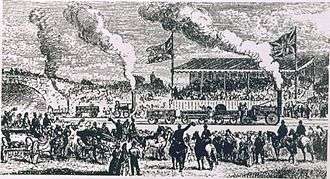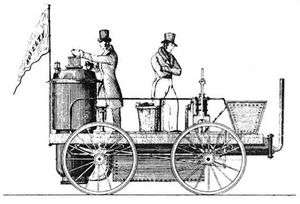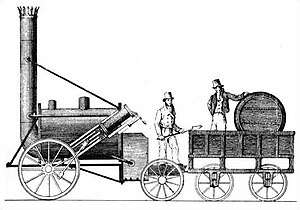Rainhill Trials

The Rainhill Trials were an important competition run in October 1829, to test George Stephenson's argument that locomotives would provide the best motive power for the then nearly-completed Liverpool and Manchester Railway (L&MR).[1] Five locomotives were entered, running along a 1 mile (1.6 km) length of level track at Rainhill, in Lancashire (now Merseyside).
Stephenson's Rocket was the only locomotive to complete the trials, and was declared the winner. The directors of the L&MR accepted that locomotives should operate services on their new line, and George and Robert Stephenson were given the contract to produce locomotives for the railway.
Background
The directors of the Liverpool and Manchester Railway had originally intended to use stationary steam engines to haul trains along the railway using cables. They had appointed George Stephenson as their engineer of the line in 1826, and he strongly advocated for the use of steam locomotives instead.[1] As the railway was approaching completion, the directors decided to hold a competition to decide whether locomotive could be used to pull the trains; these became the Rainhill Trials.[2] A prize of £500 (equal to £40379 today) was offered to the winner of the trials. Three notable engineers were selected as judges: John Urpeth Rastrick, a locomotive engineer of Stourbridge, Nicholas Wood, a mining engineer from Killingworth with considerable locomotive design experience, and John Kennedy, a Manchester cotton spinner and a major proponent of the railway.
Rules
The L&MR company set the rules for the trials. The rules went through several revisions; the final set, under which the competition was held, was:
- "The weight of the Locomotive Engine, with its full complement of water in the boiler, shall be ascertained at the Weighing Machine, by eight o'clock in the morning, and the load assigned to it shall be three times the weight thereof. The water in the boiler shall be cold, and there shall be no fuel in the fireplace. As much fuel shall be weighed, and as much water shall be measured and delivered into the Tender Carriage, as the owner of the Engine may consider sufficient for the supply of the Engine for a journey of thirty-five miles. The fire in the boiler shall then be lighted, and the quantity of fuel consumed for getting up the steam shall be determined, and the time noted."
- "The Tender Carriage, with the fuel and water, shall be considered to be, and taken as a part of the load assigned to the Engine."
- "Those engines which carry their own fuel and water, shall be allowed a proportionate deduction from their load, according to the weight of the Engine."
- "The Engine, with the carriages attached to it, shall be run by hand up to the Starting Post, and as soon as the steam is got up to fifty pounds per square inch (3.4 bar), the engine shall set out upon its journey."
- "The distance the Engine shall perform each trip shall be one mile and three quarters (2.8 km) each way, including one-eighth of a mile (200 m) at each end for getting up the speed and for stopping the train; by this means the Engine, with its load, will travel one and a-half mile (2.4 km) each way at full speed."
- "The Engines shall make ten trips, which will be equal to a journey of 35 miles (56 km); thirty miles whereof shall be performed at full speed, and the average rate of travelling shall not be less than ten miles per hour (16 km/h)." (Note: The only other passenger railway in the world at that time, the Stockton and Darlington Railway, had an average speed of only about 8 miles per hour (13 km/h).)
- "As soon as the Engine has performed this task, (which will be equal to the travelling from Liverpool to Manchester,) there shall be a fresh supply of fuel and water delivered to her; and, as soon as she can be got ready to set out again, she shall go up to the Starting Post, and make ten trips more, which will be equal to the journey from Manchester back again to Liverpool."
- "The time of performing every trip shall be accurately noted, as well as the time occupied in getting ready to set out on the second journey."[3]
- "The gauge of the railway to be 4 ft 8 1⁄2 in (1,435 mm)."
Entries
Ten locomotives were officially entered for the trials, but on the day the competition began — 6 October 1829 — only five locomotives were available to run:[4]
- Cycloped, a horse-powered locomotive built by Thomas Shaw Brandreth.
- Novelty, the world's first tank locomotive, built by John Ericsson and John Braithwaite.
- Perseverance, a vertical boilered locomotive, built by Timothy Burstall.
- Rocket, designed by George and Robert Stephenson; built by Robert Stephenson and Company.
- Sans Pareil, built by Timothy Hackworth.[2]





Competition
The length of the L&MR that ran past Rainhill village was straight and level for over 1 mile (1.6 km), and was chosen as the site for the Trials. Two or three locomotives ran each day, and several tests for each locomotive were performed over the course of six days.[2]
Cycloped was the first to drop out of the competition. It used a horse walking on a drive belt for power, and was withdrawn after an accident caused the horse to burst through the floor of the engine. The next locomotive to retire was Perseverance, which was damaged in transit to the competition. Burstall spent the first five days of the trails repairing his locomotive, and though it ran on the sixth day,it failed to reach the required 10 miles per hour (16 km/h) speed and was withdrawn from the trial. It was granted a £25 consolation prize (equal to £2019 today).
Sans Pareil nearly completed the trials, though at first there was some doubt as to whether it would be allowed to compete as it was 300 pounds (140 kg) overweight. However, it did eventually complete eight trips before cracking a cylinder. Despite the failure it was purchased by the L&MR, where it ran for two years before being leased to the Bolton and Leigh Railway.
The last locomotive to drop out was Novelty. In contrast to Cycloped, it used advanced technology for 1829, and was lighter and considerably faster than the other locomotives in the competition. It was the crowd favourite and reached a then-astonishing 28 miles per hour (45 km/h) on the first day of competition. It later suffered damage to a boiler pipe which could not be fixed properly on site. Nevertheless, it ran the next day and reached 15 miles per hour (24 km/h) before the repaired pipe failed and damaged the engine severely enough that it had to be withdrawn.
The Rocket was the only locomotive that completed the trials. It averaged 12 miles per hour (19 km/h) and achieved a top speed of 30 miles per hour (48 km/h)) hauling 13 tons, and was declared the winner of the £500 prize (equal to £40379 today). The Stephensons were given the contract to produce locomotives for the L&MR.[5]
Rocket 150
| Wikimedia Commons has media related to Rocket 150. |
In 1980 the Rocket 150 celebration was held to mark the 150th Anniversary of the trials.
A replica of Novelty was built for the event, which was also attended by replicas of Sans Pareil and Rocket (plus coach). On the first day of the Trials, disaster struck. The Rocket, to the dismay of the many visitors, failed to run. It came off the rails as it was exiting the Bold Colliery sidings and buckled its 2 large drive wheels. That evening, senior staff from a local road transport company met the builder of the Rocket replica, at a Liverpool Hotel and agreed that, in the early hours of the following morning, they would urgently manufacture some steel parts (wedges) in their nearby workshops, to fix the bent drive wheel before the second day's parade commenced. At the same time, BR agreed to put a team of staff into the sidings at Bold to "straighten" the bent rails. Both activities were achieved on time and the Rocket ran successfully on the following 2 days of the Trials.
The event was also attended by:
- Lion, at the time of Rocket 150 the oldest operable steam locomotive in existence
(The British-built US locomotive John Bull, seven years older, was steamed again in 1981) - Flying Scotsman No. 4472
- LMS 4-6-0 Jubilee class No. 5690 Leander
- Sir Nigel Gresley No. 4498
- GWR 0-6-0 No. 3205
- LMS Class 4 MT 2-6-0 No. 43106
- BR 92220 Evening Star, the last steam locomotive to be built by British Railways
- LMS 4-6-2 Princess Elizabeth No. 6201
Two Class 86 locomotives 86214 Sans Pareil[6] and 86235 Novelty[7] were painted in a variation of the Large Logo Rail Blue livery where the BR logo was replaced by Rocket 150 motif on a yellow background.
Restaging
In a recent (2002) restaging of the Rainhill Trials using replica engines, neither Sans Pareil (11 out of 20 runs) nor Novelty (10 out of 20 runs) completed the course. In calculating the speeds and fuel efficiencies, it was found that Rocket would still have won, as its relatively modern technology made it a much more reliable locomotive than the others. Novelty almost matched it in terms of efficiency, but its firebox design caused it to gradually slow to a halt due to a buildup of molten ash (called "clinker") cutting off the air supply. The restaged trials were run over the Llangollen Railway, Wales, and were the subject of a 2003 BBC Timewatch documentary.
This restaging should not be taken as accurate as there were major compromises made for television and because of the differences in crew experience, the fuel used, the modifications made to the replicas for modern safety rules, modern materials and construction methods, and following operating experience. Sensible comparisons were made between the engines only after calculations took into account the differences.
None of the replicas were without major differences from the 1829 originals.
References
- 1 2 Cleveland-Stevens, Edward Carnegie (1915). English Railways: Their Development and Their Relation to the State. Routledge.
- 1 2 3 Wolmar, Christian (2007). Fire and Steam. London: Atlantic Books. p. 36. ISBN 1-84354-629-9.
- ↑ Stephenson, Robert; Locke, Joseph (February 1830). "Account of the Competition for Locomotive Engines". Written at Liverpool. Observations on the Comparative Merits of Locomotive and Fixed Engines as Applied to Railways (PDF). Philadelphia: Carey & Lea (published 1831). p. 107. Retrieved 2008-08-30.
- ↑ Hendrickson, III, Kenneth E. (25 November 2014). The Encyclopedia of the Industrial Revolution in World History. 3. Rowman & Littlefield.
- ↑ Wolmar, Fire and Steam, pp. 36-37
- ↑ Marsden, Colin (1981). Motive Power Recognition :1 - Locomotives. Shepperton: Ian Allen Ltd. p. 133. ISBN 0-7110-1109-5.
- ↑ Nixon, Les (1983). BR Colour Album. London: Jane's Publishing Company Limited. p. 11. ISBN 0-7106-0287-1.
- Dendy Marshall, CF (1929). "The Rainhill Locomotive Trials of 1829". Transactions of the Newcomen Society. 9. Archived from the original on 19 March 2006.
External links
| Wikimedia Commons has media related to |
- Rocket and its Rivals Details of 2003 Timewatch episode at Highbeam